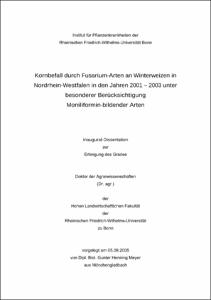Kornbefall durch Fusarium-Arten an Winterweizen in Nordrhein-Westfalen in den Jahren 2001 – 2003 unter besonderer Berücksichtigung Moniliformin-bildender Arten

Kornbefall durch Fusarium-Arten an Winterweizen in Nordrhein-Westfalen in den Jahren 2001 – 2003 unter besonderer Berücksichtigung Moniliformin-bildender Arten

| dc.contributor.advisor | Dehne, Heinz-Wilhelm | |
| dc.contributor.author | Meyer, Gunter Henning | |
| dc.date.accessioned | 2020-04-08T07:25:36Z | |
| dc.date.available | 2020-04-08T07:25:36Z | |
| dc.date.issued | 2006 | |
| dc.identifier.uri | https://hdl.handle.net/20.500.11811/2365 | |
| dc.description.abstract | Zwischen 2001 und 2003 kam es in Abhängigkeit von Jahr, Witterung, Standort und Weizensorte an den Standorten der Landessortenversuche zu einem teils extremen Auftreten von Ährenfusariosen. Regional höhere Niederschläge in Westfalen führten in allen drei Untersuchungsjahren zu einem höheren Kornbefall als im Rheinland. Im Jahr 2002 lag das Befallniveau im Rheinland höher als im Jahr 2001, während in Westfalen ein geringerer Befall auftrat. Im Jahr 2003 kam es trotz des trockenen Sommers, mit Ausnahme von Kerpen-Buir, an den Standorten zum höchsten Kornbefall aller Untersuchungsjahre. Im Durchschnitt aller Jahre trat in Nordrhein-Westfalen Fusarium avenaceum am häufigsten auf, gefolgt von F. graminearum, F. poae, F. culmorum und F. tricinctum. Die Moniliformin-bildenden Arten F. avenaceum und F. tricinctum kamen zusammen ebenso häufig vor, wie die DON-bildenden Arten F. graminearum und F. culmorum. Die Befallshäufigkeit der Körner wurde durch Sorteneigenschaften, Anbauintensität und Witterung bestimmt. Sorten mit besserer Resistenzeinstufung und zunehmender Pflanzenlänge wiesen einer geringere Befallshäufigkeit der Körner mit Fusarium spp. auf, obwohl einzelne Sorten, wie Winnetou, deutlich von ihrer Einstufung abwichen. Durch den Einsatz von Wachstumsreglern und Fungiziden in der intensiveren Anbauvariante wurden diese Sorteneigenschaften derart beeinflusst, dass eine erhöhte Befallshäufigkeit in dieser Variante insbesondere bei den langstrohigen bzw. resistenten Sorten zu beobachten war. Kurzstrohige Sorten wie Biscay oder Maverick wiesen in beiden Varianten einen gleich hohen, überdurchschnittlichen Befall auf. Die Zusammensetzung des Artenspektrums beruhte auf Standort und Vorfrucht. Zwar förderte die Vorfrucht Mais den Anteil von F. graminearum am Befall, trotzdem trat diese Art an keinem Standort dominant auf. Der hohe Anteil von F. avenaceum und F. tricinctum am Befall war jedoch nicht mit einer hohen Belastung der Kornproben mit Moniliformin korreliert, obwohl fast alle geprüften Isolate von F. avenaceum und F. tricinctum in der Lage waren, Moniliformin in vitro zu produzieren. Die höchste Belastung wurde mit 225 ppb in einer Probe aus dem Jahr 2003 nachgewiesen, während die meisten Proben Gehalte von unter 100 ppb aufwiesen. Bei subletalen Dosen von Azoxystrobin reagierten Isolate von F. avenaceum und F. tricinctum in vitro mit geringer Wachstumshemmung, aber einem erhöhten Moniliformingehalt, während Tebuconazol das Wachstum stark hemmte ohne die Moniliforminproduktion zu beeinflussen. | |
| dc.description.abstract | Grain infection by Fusarium species of winter wheat in Northrhine-Westphalia in the years 2001 – 2003 under special observance of moniliformin producing species Depending on year, weather, location and wheat cultivar, some partially high incidences of Fusarium head blight have been observed in Northrhine-Westphalia between 2001 and 2003. In all three years higher precipitation in Westphalia caused higher levels of grain infection than in the Rhineland. In the Rhineland the level of infection in 2002 was higher than in 2001, while in Westphalia it was lower than the year before. Despite the hot summer, at all locations, except Kerpen-Buir, the highest levels of infection occurred in 2003. In average Fusarium avenaceum was the most frequent species in Northrhine-Westphalia, followed by F. graminearum, F. poae, F. culmorum and F. tricinctum. The moniliformin producing species F. avenaceum and F. tricinctum were as frequent as the DON-producing species F. graminearum and F. culmorum. Beside the weather conditions, the level of grain infection was determinated by cultivar properties and cultivation method. Cultivars with higher FHB resistance classification und increasing plant length showed lower levels of grain infection, even though single cultivars, as Winnetou, showed deviation from their classification. Growth regulators and fungicides applied in the intensive cultivation method, resulted higher levels of infections in those cultivars with higher resistance or long straw. The Fusarium spectrum was based upon the location and the pre-crop. Even though maize promoted the proportion of F. graminearum, at no location this species was predominant. The high proportion of F. avenaceum and F. tricinctum was not correlated with a high contamination of wheat samples with moniliformin, even though almost every tested Isolat of F. avenaceum and F. tricinctum produced moniliformin in vitro. The highest contamination of a wheat sample with 225 ppb was found in 2003, while moniliformin levels of nearly all other samples were below 100 ppb. With low concentrations of Azoxystrobin in the medium, both isolates of F. avenaceum and F. tricinctum showed in vitro only weak inhibition of growth rate, but increased levels of moniliformin. Tebuconazol inhibited the growth of the mycelium strongly without influencing the concentration of moniliformin in the mycelium. | |
| dc.language.iso | deu | |
| dc.rights | In Copyright | |
| dc.rights.uri | http://rightsstatements.org/vocab/InC/1.0/ | |
| dc.subject | Vorfrucht | |
| dc.subject | Fungizid | |
| dc.subject | Sorte | |
| dc.subject | Mykotoxine | |
| dc.subject | Artenspektrum | |
| dc.subject.ddc | 630 Landwirtschaft, Veterinärmedizin | |
| dc.title | Kornbefall durch Fusarium-Arten an Winterweizen in Nordrhein-Westfalen in den Jahren 2001 – 2003 unter besonderer Berücksichtigung Moniliformin-bildender Arten | |
| dc.type | Dissertation oder Habilitation | |
| dc.publisher.name | Universitäts- und Landesbibliothek Bonn | |
| dc.publisher.location | Bonn | |
| dc.rights.accessRights | openAccess | |
| dc.identifier.urn | https://nbn-resolving.org/urn:nbn:de:hbz:5N-07643 | |
| ulbbn.pubtype | Erstveröffentlichung | |
| ulbbnediss.affiliation.name | Rheinische Friedrich-Wilhelms-Universität Bonn | |
| ulbbnediss.affiliation.location | Bonn | |
| ulbbnediss.thesis.level | Dissertation | |
| ulbbnediss.dissID | 764 | |
| ulbbnediss.date.accepted | 21.12.2005 | |
| ulbbnediss.institute | Landwirtschaftliche Fakultät : Institut für Pflanzenkrankheiten | |
| ulbbnediss.fakultaet | Landwirtschaftliche Fakultät | |
| dc.contributor.coReferee | Léon, Jens |
Files in this item
This item appears in the following Collection(s)
-
E-Dissertationen (1027)




